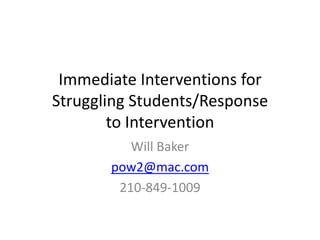
Rti Ecisd
- 1. Immediate Interventions forStruggling Students/Responseto Intervention Will Baker pow2@mac.com 210-849-1009
- 2. Agenda Fidelity Data-Based Decisions Screening Instruction Interventions in the Evidenced-Based World Making Progress
- 3. Fidelity “We do what we say we do”
- 4. Data-Based Decision Making What data do you collect? How much is too much? Who reviews that data? How is the data shared?
- 5. Screening Reading Math Behavior Writing and Spelling?
- 6. Screening How do you review the screen? How do you use the data?
- 7. Instruction What’s your program? Reading Writing Math Behavior
- 8. Instruction What’s scientifically based?
- 9. 20 USC §7801(37) The term "scientifically based research"-- (A) means research that involves the application of rigorous, systematic, and objective procedures to obtain reliable and valid knowledge relevant to education activities and programs; and (B) includes research that– (i) employs systematic, empirical methods that draw on observation or experiment; (ii) involves rigorous data analyses that are adequate to test the stated hypotheses and justify the general conclusions drawn; (iii) relies on measurements or observational methods that provide reliable and valid data across evaluators and observers, across multiple measurements and observations, and across studies by the same or different investigators; (iv) is evaluated using experimental or quasi-experimental designs in which individuals, entities, programs, or activities are assigned to different conditions and with appropriate controls to evaluate the effects of the condition of interest, with a preference for random-assignment experiments, or other designs to the extent that those designs contain within-condition or across-condition controls; (v) ensures that experimental studies are presented in sufficient detail and clarity to allow for replication or, at a minimum, offer the opportunity to build systematically on their findings; and (vi) has been accepted by a peer-reviewed journal or approved by a panel of independent experts through a comparably rigorous, objective, and scientific review.
- 10. Commissioner’s Rules (i) data that demonstrates the child was provided appropriate instruction in reading (as described in 20 USC, §6368(3)), and/or mathematics within general education settings delivered by qualified personnel; and
- 11. Principle #1 Neurons wire together fire together Implications Repetition Review (10-24-7) Circuit Learning Mnemonics and associative memory
- 12. Principle #2 The Search for Meaning is Innate The Brain Looks for Patterns The Brain Likes Routine The Brain Pays Attention to Differences Parts and Wholes
- 13. red blue green purple orange pink yellow white
- 14. Principle #3 Positive emotion = greater learning Cooperation Positive reinforcement Interesting instruction Amygdala and hippocampus
- 15. Principle #4 Everything speaks Incidental versus direct learning The power of modeling and demonstration The physical environment Music
- 16. Nonconscious Learning 99% Conscious Learning 1% Nonconscious vs. Conscious Learning Information taken from Brain-Based Learning, Eric Jensen, San Diego California: the Brain Store, Inc, 1995.
- 17. Principle #5 There is no comprehension without visualization The power of spatial memory Concrete learning
- 18. Reading Quiz 'Twas brillig, and the slithy tovesDid gyre and gimble in the wabe.All mimsy were the borogroves,And the mome raths outgrabe. 1) What things were slithy? 2) What did the toves do in the wabe? 3) How were the borogroves? 4) What kind of raths were there?
- 19. Principle #6 Enhanced by challenge, inhibited by threat Rubik’s cube Zone of Proximal Distance Intrinsic and extrinsic motivation
- 20. Interventions What do you use? Who provides? Where? When?
- 21. Progress Monitoring How do you measure progress? How do you define progress?
- 22. Putting it all together Does it make sense? Is it clear? Do you teach your process?
- 23. What next? A goal without a plan is just a wish. Antoine de Saint-Exupery (1900 - 1944) In the absence of clearly-defined goals, we become strangely loyal to performing daily trivia until ultimately we become enslaved by it. Robert Heinlein (1907 - 1988)
